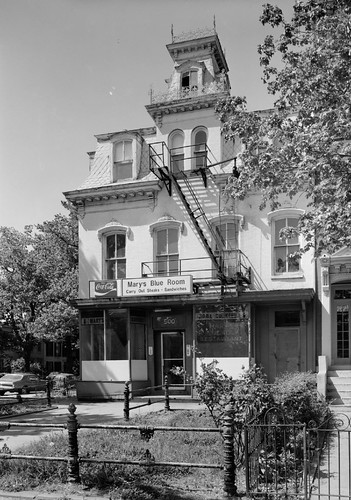Losing my religion part 27
The law proposing an exemption for churches from the DC Historic Preservation Act has reared its ugly head again. Churches shouldn't get a pass from building regulations. Otherwise we will get more demolition by neglect and more parking lots abutting churches in residential zones.
The frame houses, constructed in 1876, that were on this lot were allowed to rot by the Pilgrim Baptist Church, to be replaced by a parking lot. Yet the parking lot required a variance, because the Church didn't meet the regulatory requirements for off-site parking in a residential zone. The Dept. of Consumer and Regulatory Affairs gave them a permit incorrectly, but religious types on the ANC wouldn't support an ANC6A challenge to the granting of the permit.

Wouldn't you rather have two houses on these lots, paying property taxes, having residents paying income taxes, adding eyes to the street, having residents engaged in community affairs, rather than a hole in the street fabric getting used maybe 3 hours per week?

The house on the right was owned by the Pilgrim Baptist Church for more than 15 years and remained unoccupied and neglected during that time. They were shocked to be accused of creating a nuisance. Technically, they didn't own the property on the left until much later, however, I argue that their neglect of the abutting property drove the other one into the gutter, creating a kind of noxious use, and making the Church the only "logically interested party" willing to purchase the dilapidated property.
There are many similar examples across the city, the recent battles over the Shiloh Baptist Church's ownership of a slew of neglected properties in the Shaw neighborhood being one example. See "A Thwarted Renaissance Near the Convention Center," from the Washington Post.
Ironically, DC's historic preservation law was crafted and passed in response to a church's demolition of properties in the Capitol Hill Historic District--which at that time was listed on the National Register of Historic Places, but preservationists learned the hard lesson that listing on the National Register only protects buildings from _federal_ undertakings.
History is getting rolled back...

This building, at the NE corner of 5th and East Capitol Streets, was demolished by the Capitol Hill Baptist Church in the mid-1970s. They claimed economic hardship limiting their ability to maintain the building, and they had parking lots there for decades. Ironically, in the late 1990s, they sold these lots on which new, high-cost, rowhouses were built. (Photo: Historic American Building Survey.)
-----------------
From email:
On June 10th, Councilmember Marion Barry introduced the "RELIGIOUS FREEDOM AND HISTORIC PRESERVATION CONFORMANCE AMENDMENTS ACT OF 2008". Among other things, this act would amend the DC HP Act to require that:
-- the Review Board shall not designate the property owned and used by a religious institution for religious exercise as an historic landmark or a contributing building to an historic district if the religious institution submits, at least twenty days prior to any designation hearing, a substantial religious burden statement objecting to such designation;
-- Any property owned and used by a religious institution for religious exercise that was designated an historic landmark after November 16, 1993, over the objection of the religious institution based on the substantial burden such designation would impose on its religious exercise shall be removed from and not be listed in the D.C. Inventory of Historic Sites, and shall be exempt from the provisions of the Historic Landmark and Historic District Protection Act, if the religious institution submits a substantial religious burden statement to the Historic Preservation Review Board
-- Any property owned and used by a religious institution for religious exercise that was designated a contributing building to an historic district after November 16, 1993, over the objection of the religious institution based on the substantial burden such designation would impose on its religious exercise shall be reclassified as a noncontributing building to that historic district, if the religious institution submits a substantial religious burden statement to the Historic Preservation Review Board.
If there is a religious burden imposed by DC building regulations, something which I do not see created by either the preservation laws or building regulations more generally, religious institutions are afforded protections under federal law, specifically the Religious Land Use and Institutionalized Persons Act.
However, "religious burden" is not posed by not allowing a church to tear down a steeple, or to create parking lots from what were once houses.
I am neither a lawyer nor a Constitutional scholar, and I am a strong supporter of the First Amendment and the disestablishment clause. However, the practice of religion or "official state-sanctioned" religion is a much different question than whether or not a Church seeks to treat its property in community-supporting ways.
Labels: building regulation, churchly blight, historic preservation



0 Comments:
Post a Comment
<< Home